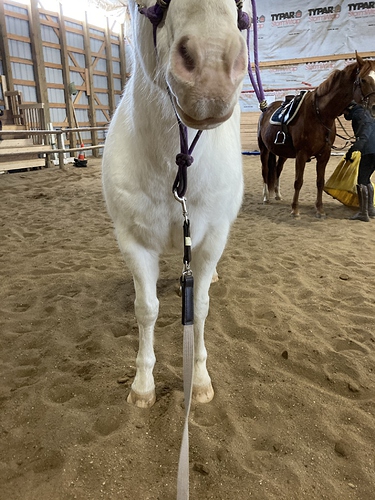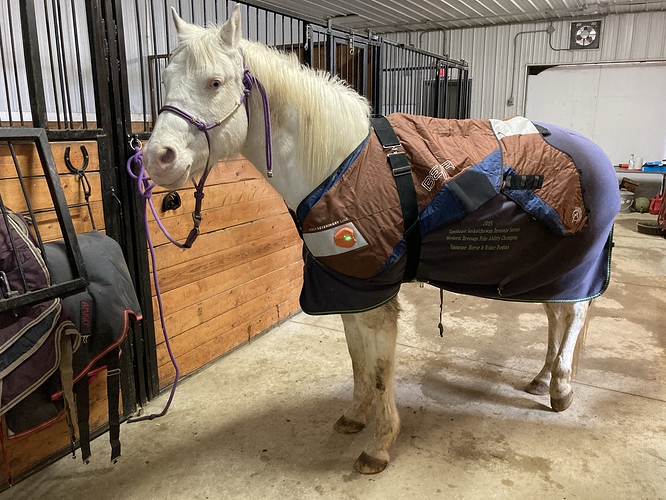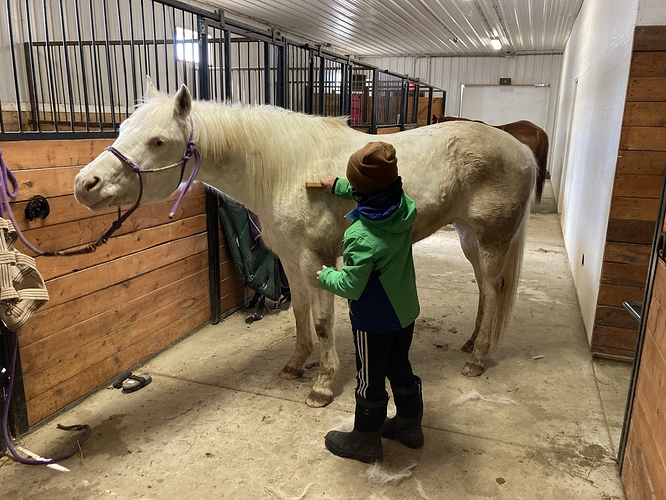That is great! Don’t be overly concerned if he backslides a bit at times. Getting the management right isn’t a linear progression. More of a trial and error thing. I’m betting you’ll have found equilibrium by the end of April/early May.
Nope no test, another disease I know little about, but if opossums are key, the we don’t have them here, soporific unlikely?
EPM can come in via contaminated hay and feed. Horses do not have to have direct contact.
Well the hay is all locally sourced, so not worried there. Can EPM survive processing of feed?
Well timed post, yesterday wasn’t good, sound, moving well, but look at the asymmetry in his shoulders! He couldn’t do his stretches on his off fore at all. Call into vet to see what she thinks.
Muscle damage is part of PSSM. It can be a vicious circle as the horse needs to burn the stored glycogen to keep the amount down, but muscle damage reduces the available muscle to burn glycogen while increasing the demand on the remaining muscle. The worst case is full blown tying up, but even if the never gets to that point there can be muscle damage occuring.
My guy never actually tied up but there was a time his muscles felt like dry rubber cement. If you’ve ever played with a blob of dry rubber cement you know you can stretch it out and it sort of slowly oozes back into the starting shape when you let go. That was the best description I could come up with for how his movement felt. I think he was pretty close to tying up at that time.
It takes some practice in “being mean” and taking your beloved horse out when he’s not feeling good and making him work (even if just low key walking). It’s so important and in the beginning kind of scary because you worry about pushing too far and causing tying up. It’s the balance of asking for as much as they can do without pushing them to do more than what they can do.
It is hard!
One thing that might help is keeping him as warm as you can without letting him overheat. It’s helpful for some horses.
Skunks can carry it too.
Yes, it can. It’s less likely to survive in pelleted feeds because of the heat used in processing. From what I understand, it is considered less likely, but possible. The occysts can live up to a year, I think? Silly question – is the horse from your general vicinity or did he arrive from elsewhere prior to purchase?
He was born in Maryland, but came north to Canada as a weakling. I’m not sure how long EPM survives dormant in the body.
So far we seem to be making progress, he’s a lot better now the weather is warming up, and certainly better if he is worked regularly
Typo? Weakling or yearling?
He was born in Maryland, but came north to Canada as a weakling. I’m not sure how long EPM survives dormant in the body.
I’m not sure. Probably within a few months, I’d think. My shire gelding showed clinical signs of EPM maybe 3-4 months after I moved him to a boarding barn while going thru a divorce. Fairly sure he caught it at the boarding barn & not our farm. Hard to say for sure, though.
There’s some research suggesting that it can lay dormant & reinfect the horse at a point when his immune system is weakened due to other causes. (Lyme & Bartonella can do this, too.) But unless i’m misinterpreting the data, it appears that those horses have been clinically ill with EPM to the point of receiving a Dx in the past.
Typo? Weakling or yearling?
 Schrodingers typo! Weanling is what I was aiming at
Schrodingers typo! Weanling is what I was aiming at
If they are asymptomatic, the critters could hang around indefinitely was the last I heard. They don’t go away unless treated. Not aware its contagious from horse to horse, only through possums. Heard of horses with symptoms getting diagnosed looong after and very far away from any possible possum exposure.
As an APHA breeder; it’s much more likely this is all due to PSSM, and not EPM. I would put that out of your head as something very unlikely.
There is a website being managed by a FB group I’m familiar with: https://pssmawareness.com/
There are several FB groups dedicated to trying to manage these conditions as well: https://www.facebook.com/groups/833944333446431
The good news is, you most likely will be able to - at some point - get it under control. The bad news is, it won’t ever totally go away.
One of my best friends has a multiple world champion gelding who was diagnosed as N/P1 as an 8 year old. He stays comfortable most days, though she’s retired him from showing.
I hope you’re able to get him comfortable and his episode is short lived. He seems like a wonderful fellow and I LOVE your photoshoot!
I will say, on my soapbox, not to the OP but to anyone reading - this is why no one should breed PSSM carriers. There is a loud minority on social media who say PSSM is “not a big deal” and “easily managed” and compare it to HYPP horses. Unfortunately, that isn’t true at all - it’s an autosomal dominant disease - which means that it only requires one gene to manifest. While some horses get very lucky and never have an episode, others get very unlucky. It’s a disease present in many stock breeds (AQHA/APHA/ApHC) as well as some draft and warmblood lines and can be “no big deal” or “catastrophic”, but you won’t know until those horses are born.
Thank you @Arelle, I am happy, if that’s the word, with the PSSM1 diagnoses, and we’ll go with that, everything points to that causing his issues. I am getting ever more certain that we are on the right track, and with the warmer weather coming, pretty confident we can have a good summer. Now we have the knowledge I will be able to help him out before he has to scream that he’s having issues.
I so agree with you on the breeding front, I took a verbal assurance that he was 5 panel negative, because he was a working stud, so OF COURSE he would be tested…lesson learned again, people suck. Think I said up thread turns out his damn carries a HYYP marker as well as PSSM1, so yes I might be lucky.
Mellow and I both had BEMER treatments today, both enjoyed it, amd will wait to see if we feel different on going.
Also for the first time the Teflon Pony was dirty yesterday, I did once joke that he stayed clean because he never laid down, now I’m thinking that wasn’t a joke, but was in fact a clue. Good job he is a barn favourite, it was easy to find a groom to do the dirty work.
The thing about PSSM is it’s not an absolute. The heart of the disease is the way the horse stores glycogen.
Normal horses store glycogen with many branchings upon branchings. Imagine a hedgehog - each spine is a glycogen link. Now imagine each spine on the hedgehog has another hedgehog with all its spines. Imagine another layer of hedgehogs on those spines, and another on those, and another, and so on. When it comes time to break down this storage molecule the horse’s muscles can snap off every free spine simultaneously which means that mass of hedgehogs is going to be gone PDQ!
Now imagine a fork. Each tine is one glycogen link, or one hedgehog spine. Add a new fork to each tine. And another to each of those tines, and so on until you have the same number of tines in the fork storage molecule as you did spines in the hedgehog molecule. As the horse’s muscles can only break off the free tines you can see it’s going to take a lot longer to get the energy out of this fork storage design.
The ultimate bad storage occurs sometimes. That would be the chain - one to one to one to one… That leaves only two places for the horse to break off glycogen links. Horses that make chains of glycogen die very young as their bodies can’t get enough fuel to survive.
How close your individual horse is to hedgehogs or forks in how they store glycogen will determine how easily it will be to manage that individual’s PSSM. Even half hedgehogs is going to be a lot easier than forks.
Which is why I try to immediately shut down anyone thinking of breeding a PSSM carrier.
Yes, THAT horse may have gotten lucky and had a bunch of hedgehogs. BUT it’s offspring may have gotten sporks. It’s not a disease where you need two copies for things to go wrong, you only need one - and you have no idea if your horse will live a long and comfortable life, or have to be euthanized before they’ve ever lived.
The OP is lucky in that her horse is at least under saddle and an adult, which tells me his particular affliction CAN be managed to some degree - but it will take trial and error, and even with the best management, you still might have bad moments. My friend I referenced above has spent thousands with a large equine veterinary hospital to ensure the best of care for her gelding, and even so - there have been a couple mornings over the last few years when she’s walked out to the barn and he can barely move.
Blessing and a curse - we actually didn’t know about PSSM until recently (like the last couple of decades). I seem to remember a top APHA stallion coming out a few years ago stating he’d been tested and was a carrier. It immediately ended his career as a stallion, but I was thankful the owners were upfront and honest about it.
More of these things are going to crop up as science gets more and more advanced.
I recently saw an ad for a lovely mare that had tested positive and her owner, a breeder, wasn’t going to be able to use her for that purpose and so was selling. I briefly toyed with the idea of inquiring after her, but then decided I did not need another headache to manage - even though the trainer, who was advertising the mare for the owner, said she had shown no symptoms. Then I was tempted to inquire for the express purpose of seeing to it that she was never bred. But I can’t justify that. I just hope that when she is sold, she is not allowed to reproduce. But sadly, people being who and what they are, I’m betting that she will.
Exactly! People who shrug it off as easily managed got lucky.
My horse is manageable. Now. Fifteen years after I found out I now know what he needs and confess to being rigid about it. And yes, along the way things happened that made his management more rigid. I was actually doing almost everything right when I found out. If he’d been under conventional management back then he would have had a hard time because almost no one knew enough about it to recognize PSSM.
I would not pass on a horse just because it had PSSM (given it was managed and the horse was doing what I wanted to do without issue) but I wouldn’t breed that horse.
Well, don’t know if it’s the Bemer treatment, warmer weather, Vitamin E and Magnesium, getting him moving more, but today Mellow was, well Mellow. Was interested but not freaked about the snow avalanches off the arena roof, wanted scratches and interaction, put a roller on to lunge him and got no ear pinning or face pulling.
The way he has been, was wondering if I would ever ride him again, today it seems very close. Just want to build up his muscle time a little more, and then throw a crash test dummy up!
I know that this is a roller coaster, but the highs are getting higher and the lows aren’t so low. He wanted scratchies and loving, something he has not wanted for a while!
Awesome! It was like that for my horse. A slow, gradual return to “normal” with some bad days here and there. Mine got diagnosed in early December and I had a different horse by April. There were bumps in the road afterwards, but when you can look at the horse’s behaviour through the PSSM lens it’s often possible to stop backslides before they get really bad.
 <- Mellow
<- Mellow



